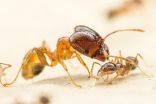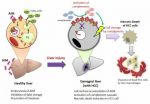York academics reveal new findings about insect diversification
2014-10-02
(Press-News.org) Biologists from the University of York have compiled two new datasets on insect evolution, revealing that metamorphosing insects diversify more quickly than other insects and are therefore the biggest contributors to the evolution of insect diversity.
Both funded by the Natural Environment Research Council (NERC), the first dataset is a complete fossil catalogue showing timescales of origination and extinction of different families of insects. Working with the Natural History Museum and National Museums Scotland, former PhD student Dr David Nicholson collated a database of 1500 fossil families, a third of which are entirely new to the record since 1993.
Using this updated fossil record, the researchers found that families of insects that undergo metamorphosis, a pupal stage separating two different juvenile and adult stages, are less prone to extinction than other insects. Insects that have metamorphosis include moths and butterflies (Lepidoptera), beetles (Coleoptera), wasps, bees, ants (Hymenoptera) and true flies (Diptera).
This finding is supported by a second dataset compiled by PhD student James Rainford. Producing the biggest and most detailed family tree of insects displaying all living groups, the distribution of numbers of species across time is shown in minute detail, demonstrating which insect groups have achieved diversity. Again, this shows that insects that undergo metamorphosis display a greater turnover of species and therefore have a higher rate of diversification. The research is published in the Royal Society's journal Proceedings of the Royal Society B.
Dr Peter Mayhew, Senior Lecturer in the Department of Biology and Supervisor to both PhD projects, said: "I have been working on the evolutionary reasons for insect diversity for over a decade. An important task is to pin down in which groups of insects the rates of diversification or extinction have changed, and which are therefore responsible for most of their richness.
"Intuitively, people have long suspected that insects with metamorphosis have experienced different rates of diversification, because the richest insect orders mostly have metamorphosis. However there has been little hard evidence to back this up. These two new datasets are comprehensive, detailed tools in confirming our intuitions and will pave the way for further research into why metamorphosis is important for insect evolution."
James Rainford said: "Early family trees were not very finely resolved, and could not easily pin down the groups where diversification rates changed. In putting together a dated family tree for the entire group we can, for the first time, view patterns of diversification in a truly global context and test long-standing ideas regarding the processes involved. These two analyses, one based only on the living groups and the other on the fossil record, agree about the importance of metamorphosis in the diversification of insect groups. This provides a strong basis for further explorations into the origin of this key part of modern ecosystems."
These two new datasets will now pave the way for future research into why metamorphosis is important for insect evolution. Dr Mayhew adds: "Metamorphosis might reduce extinction, and promote speciation, in a number of different ways. It might reduce competition between larvae and adults, it might promote dietary specialisation, it might reduce development times, it might improve survival in times of hardship, or something else. Future work needs to address this question."
INFORMATION:
ELSE PRESS RELEASES FROM THIS DATE:
2014-10-02
By combining data from two high-energy accelerators, nuclear scientists have refined the measurement of a remarkable property of exotic matter known as quark-gluon plasma. The findings reveal new aspects of the ultra-hot, "perfect fluid" that give clues to the state of the young universe just microseconds after the big bang.
The multi-institutional team known as the JET Collaboration, led by researchers at the U.S. Department of Energy's Lawrence Berkeley National Lab (Berkeley Lab), published their results in a recent issue of Physical Review C. The JET Collaboration ...
2014-10-02
As the Supreme Court of the United States begins its fall 2014 session this month, it faces decisions on several "blockbuster" cases, including freedom of speech, religious freedoms in prison, pregnancy discrimination and a possible decision on gay marriage.
Just don't expect any of these decisions until next June, just before the court's session ends.
New research from the Washington University in St. Louis School of Law finds big, or "blockbuster," cases are disproportionately decided at the end of June, just before the court's summer recess.
"We knew that more than ...
2014-10-02
Older parents, birth defects, maternal nutrition and childhood exposure to CT scans and pesticides are increasingly being associated with brain tumors in children, according to new research from the Brown School at Washington University in St. Louis.
Brain and central nervous system tumors are the second leading cause of cancer death in children.
A team of researchers, led by Kimberly Johnson, PhD, assistant professor of social work at the Brown School, a member of the Institute for Public Health and a research member of Siteman Cancer Center, examined studies published ...
2014-10-02
Where are the quantum computers? Aren't they supposed to be speeding up decryption and internet searches? After two decades of research, you still can't find them in stores. Well, it took two decades or more of research dedicated to semiconductors and circuit integration before we had digital computers. For quantum computers too it will take technology more time to catch up to the science
Meanwhile, research devoted to exploring bizarre quantum phenomena must continue to overcome or reduce a litany of practical obstacles before quantum computing can be realized. ...
2014-10-02
Montréal, October 2, 2014 – Scientists at the IRCM discovered a mechanism that promotes the progression of medulloblastoma, the most common brain tumour found in children. The team, led by Frédéric Charron, PhD, found that a protein known as Sonic Hedgehog induces DNA damage, which causes the cancer to develop. This important breakthrough will be published in the October 13 issue of the prestigious scientific journal Developmental Cell. The editors also selected the article to be featured on the journal's cover.
Sonic Hedgehog belongs to a family of proteins that gives ...
2014-10-02
CHAMPAIGN, Ill. — The big-headed ant (Pheidole megacephala) is considered one of the world's worst invasive ant species. As the name implies, its colonies include soldier ants with disproportionately large heads. Their giant, muscle-bound noggins power their biting parts, the mandibles, which they use to attack other ants and cut up prey. In a new study, researchers report that big-headed ant colonies produce larger soldiers when they encounter other ants that know how to fight back.
The new findings appear in the Biological Journal of the Linnean Society.
Big-headed ...
2014-10-02
London, United Kingdom, October 2, 2014 – Despite decades of research, scientists have yet to pinpoint the exact cause of nodding syndrome (NS), a disabling disease affecting African children. A new report suggests that blackflies infected with the parasite Onchocerca volvulus may be capable of passing on a secondary pathogen that is to blame for the spread of the disease. New research is presented in the International Journal of Infectious Diseases.
Concentrated in South Sudan, Northern Uganda, and Tanzania, NS is a debilitating and deadly disease that affects young ...
2014-10-02
A new study published in the Cell Press journal Current Biology on October 2 could rewrite the story of ape and human brain evolution. While the neocortex of the brain has been called "the crowning achievement of evolution and the biological substrate of human mental prowess," newly reported evolutionary rate comparisons show that the cerebellum expanded up to six times faster than anticipated throughout the evolution of apes, including humans.
The findings suggest that technical intelligence was likely at least as important as social intelligence in human cognitive ...
2014-10-02
The more curious we are about a topic, the easier it is to learn information about that topic. New research publishing online October 2 in the Cell Press journal Neuron provides insights into what happens in our brains when curiosity is piqued. The findings could help scientists find ways to enhance overall learning and memory in both healthy individuals and those with neurological conditions.
"Our findings potentially have far-reaching implications for the public because they reveal insights into how a form of intrinsic motivation—curiosity—affects memory. These findings ...
2014-10-02
This release is available in Japanese.
A University of Tokyo research group has discovered that AIM (Apoptosis Inhibitor of Macrophage), a protein that plays a preventive role in obesity progression, can also prevent tumor development in mice liver cells. This discovery may lead to a therapy for hepatocellular carcinoma (HCC), the most common type of liver cancer and the third most common cause of cancer deaths.
Professor Toru Miyazaki's group at the Laboratory of Molecular Biomedicine from Pathogenesis, in the Faculty of Medicine has shown that AIM (also known ...
LAST 30 PRESS RELEASES:
[Press-News.org] York academics reveal new findings about insect diversification




